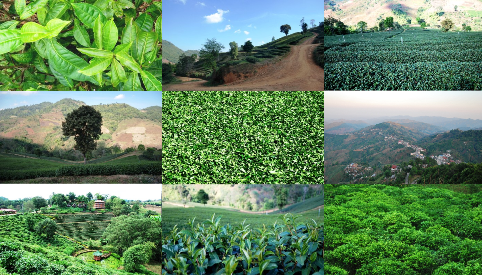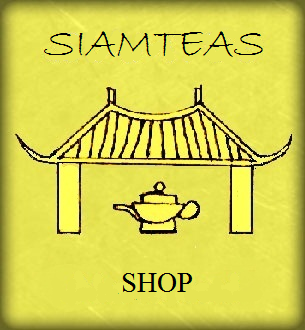Tea Production in Doi Mae Salong, North Thailand: the picking and processing of our Oolong Nr.12 Jin Xuan
The following video on tea production shows “the becoming” of our Jin Xuan Oolong No.12, a light-fermented Oolong tea produced from the Jin Xuan tea cultivar, which – together some other Taiwanese tea cultivars such as the Ruan Zhi Oolong No.17 tea cultivar, the Four Seasons Oolong tea cultivar and the Qing Xin Oolong tea cultivar – had been imported from Taiwan for cultivation in the mountains of North Thailand starting from about the late 1980s/ early 1990s. The effort has definitely been worth it, as the following little film on the picking and production of Jin Xuan Oolong Tea in Doi Mae Salong, north Thailand, clearly demonstrates.
Curious about trying Jin Xuan Oolong No. 12 or another Thai Oolong Tea?
click here to check our offer of Thai Oolong Teas at Siam Tea Shop
Tea Processing
Principally, three main categories of tea processing can be differentiated: the processing to
• Green tea (not fermented)
• Oolong tea (part-fermented)
• Black tea (fully fermented)
Dependent upon country and region of cultivation and the equipment available to a producer, however, there are various individual procedures and methods within each main category that can differ from region to region, from producer to producer, and from specialty to specialty. This makes a comprehensible representation of all possibilities a difficult task and leads to perceived contradictions and confusions in much of the available literature. Two more (sub-) categories can be added to the above-mentioned classification
• White tea (very light fermented)
• Pu Erh tea (post-fermented)
In the following representation, we take orientation on the conditions of tea production at our producer partners in Doi Mae Salong, North Thailand, as detailed in the above video for our Oolong No.12. The description therefore uses no further picture illustrations. However, vivid photographic illustrations of the individual tea processing procedures in North Thailand can be found in our articles
and
Pang Kham – Tea Village in No-Man’s-Land
Tea Harvesting
The harvesting/plucking conditions are crucial factor for a tea’s quality! Respectively only the youngest shoots of the tea plant should be picked, in the best only 2 youngest leaves with their corresponding tip (bud). It is obvious that no machine in the world can do this accurately, so we can say that the best teas will always be handpicked. Then, the best location for the cultivation of tea are sunny, often steep hillsides, where the picking by hand might be arduous, but the access by machine even more difficult, where not impossible. Machine-picked teas from plain locations, will therefore mainly be mass teas. As such, these don’t have to be necessarily ‘bad’, but they won’t make it to the higher ranks.
Dependent on type of tea and plant species, tea plants can be harvested several times per year. In North Thailand, harvests take place from the middle of February until October, as is typical for the most cultivation areas. There’s no tea harvested during ‘winter’ (exception here: our Jin Xuan “Hoarfrost” Oolong Tea from a Jin Xuan winter harvest). The first harvests of the year are considered as best quality and particularly covetable.
Withering of the Tea Leaves
After the picking, as a second step of tea production, the tea leaves are spread in the open to ‘wither’ in the sun. Just as in all following processing steps, the tea leaves will loose moisture and become more malleable in this process. No fermentation takes place at this stage yet. During this phase, the tea leaves are constantly flipped over and swirled. The producer/tea master continuously examines the leaves and decides, when the time is right for the next processing step.
Fermentation / Oxidation
What is commonly often referred to as fermentation is in fact more exactly an oxidation. The juices in the tea leaf react with oxygen. This is one of the most crucial steps in tea production / tea processing, as it basically decides which type of tea is being produced: green tea, Oolong tea or black tea. The oxidation process sets in automatically at a certain stage of drying of the leaves and for Oolong tea is facilitated by a breaking up of the leaf surfaces. Hence, for oolong teas, the continuous flipping over and swirling of the tea leaves during the withering and fermenting does not only serve the consistency of processes for all leaves of a lot, but is done in a rough way on purpose, in order to break up the leaf surfaces. The cracks will still be recognizable on the final product’s tea leaf in form of brownish stains, whereas the color is a result of the oxidation of the exiting leaf juices. For green tea, the processing stage of controlled fermentation is omitted.
Green Tea
For the production of green tea the oxidation process is stopped after the withering of the tea leaves. For this purpose, the tea leaves are heated to a temperature, where the enzymes responsible for the fermentation deteriorate. After this, the tea leaves are optionally subjected to a shaping process (rolling to needles, curls or granules), before they enter the final drying (today mostly by hot air).
White Tea
A peculiarity at the processing of white tea is the prolongation of the withering phase beyond the setting in of the oxidation process. The result is a very lightly fermented tea, which in a way is an ‘interim form’ between green tea and Oolong tea.
Pu Erh Tea
The processing of Pu Er tea has a special status among the different methods of tea production. Pu Erh teas are also heat-dried after the withering in the sun, but at a comparably low temperature, so the fermentation process will not be completely inhibited. Then, the tea leaves once again spread out in the sun and left there to dry completely. During this stage of sun-drying, a post-fermentation process sets in. The ready sun-dried tea leaves are referred to as Maocha. If the Maocha is left to the natural course of the post-fermentation process, which can extend over years, the end product is a ‘raw’ Pu Erh or sheng Pu Erh tea. To shorten this process for obvious commercial reasons, a special procedure was developed in China to promote and accelerate the ripening process. The end product of this procedure, resembling a composting process, is referred to as ‘ripened’ Pu Erh or shu Pu Erh tea.
Though the Pu Errh method and tradition has its origins in China’s Yunnan province, at the city of Pu Errh, it was introduced and adopted in Taiwan and other regions of mainland China and South East Asia at an early stage. Strictly speaking, only Pu Errh teas originating from Yunnan province should be referred to as such.
Oolong Tea
The skilled processing of part-fermented tea (Oolong tea) is the most complex and elaborate tea production method and requires the tea master’s constant supervision. After the first withering of the tea leaves in the sun, they are brought inside, where they are distributed evenly in a thin layer on large bamboo trays and stacked in such way that allows free air and manual access to each level. During this ‘inside withering’, the tea leaves are again repeatedly flipped over and swirled to ensure a consistent drying and fermentation. Das Drehen und Verwirbeln erfolgt mit absichtlicher Rohheit, um die Blattoberflächen aufzubrechen und so für einen gleichmäßigen und beschleunigten Fermentierungsprozess zu sorgen.
The tea master decides when the desired degree of fermentation for each processed tea is achieved. Once this point is reached, the tea leaves are heated to stop the enzymatic activity and thereby inhibit further fermentation. During the withering and heating procedures, moisture is continuously extracted from the tea leaves. They become more and more malleable, which facilitates the ensuing forming process.
The Rolling
Of course, many teas are simply left in their natural leaf form. In ancient times, the rolling to granules, needles or curls was done manually during the drying (e.g. in the wok). Today, however, it will mainly be done by machines: The malleable tea leaves are wrapped and pressed in a cloth to a bale and this bale then churned with a special machine. At this, the leaf surfaces are further broken up and the tea leaves will assume the desired shape. For Oolong teas, the cycle of heating the tea leaves and churning the bales under pressure is repeated several times, dependent on the type of tea produced. Then the tea leaves are transferred to end drying.
Black Tea
For the production of black tea, the fermentation process of the tea leaves is allowed to fully complete.
End Sorting
High quality teas are subjected to an end sorting process, where especially off-colors and second choice leaves and leave parts are picked out.
Green, Oolong and black teas from the production of our producer partner in North Thailand, a small family operation in Doi Mae Salong, as well as a Pu Errh style tea harvested from wild growth tea trees and produced by the Shan people local to North Thailand are available online in our










A beautiful video, so informative and delightful. It is relaxing to watch especially while sipping delicious oolong tea from Doi Mae Salong
Pingback : How Tea Fills the Cup - Tee-Ernte und Produktion in Doi Mae Salong, Nordthailand | Letha's Asian Health Secrets
Pingback : How Tea Fills the Cup – Tee-Ernte und Produktion in Doi Mae Salong, Nordthailand « Asian Health Secrets